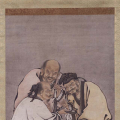Welcome home! Please contact lincoln@icrontic.com if you have any difficulty logging in or using the site. New registrations must be manually approved which may take several days. Can't log in? Try clearing your browser's cookies.
In brief. Rangtong and Shentong
 Jeffrey
Veteran
Jeffrey
Veteran
in Philosophy
RANGTONG (SELF-EMPTINESS) SCHOOL AND SHENTONG (OTHER-EMPTINESS) SCHOOL ... in meaning, these two concepts are essentially the same. Third Karmapa Rangjung Dorje said that Middle-way and Mahamudra and Dzogchen all apply to the same thing.
In the Buddhist tradition the teachings of the Buddha are divided into the sutras and tantras. In the sutra tradition, in the philosophy called Middle-way, there are two ways of thinking about emptiness which are called the Rangtong or "Self-emptiness" school and the Shentong or the "Other-emptiness" school.
The Middle-way Rangtong school emphasizes the concept of dharmadhatu. The principal nature of Mahamudra is emptiness, and this is called dharmadhatu or the realm of reality. The Middle-way Shentong school, on the other hand, focuses on the aspect of awareness (Skt. jnana) and emphasizes the concept of tathagatagarbha or literally, "the essence of the tathagatas" (Buddhas), often called Buddha-nature or Buddha essence.
In meaning however, these two concepts are essentially the same. In the tantras, based on actual meditation practice there is the emphasis on introduction or transmission which reveals the essence or nature of the mind, which we call Mahamudra. This mind's essence is basically the same as the Middle-way concepts of the sutra tradition. That is why Rangjung Dorje said that "Middle-way" and "Mahamudra," and "Dzogchen" all apply to the same thing.
THE SPIRITUAL SONG OF LODRO THAYE by ]AMGON KONGTRUL, THE GREAT
Commentary by KHABJE KHENCHEN THRANGU RINPOCHE (Originally translated by SARAH HARDING.)
In the Buddhist tradition the teachings of the Buddha are divided into the sutras and tantras. In the sutra tradition, in the philosophy called Middle-way, there are two ways of thinking about emptiness which are called the Rangtong or "Self-emptiness" school and the Shentong or the "Other-emptiness" school.
The Middle-way Rangtong school emphasizes the concept of dharmadhatu. The principal nature of Mahamudra is emptiness, and this is called dharmadhatu or the realm of reality. The Middle-way Shentong school, on the other hand, focuses on the aspect of awareness (Skt. jnana) and emphasizes the concept of tathagatagarbha or literally, "the essence of the tathagatas" (Buddhas), often called Buddha-nature or Buddha essence.
In meaning however, these two concepts are essentially the same. In the tantras, based on actual meditation practice there is the emphasis on introduction or transmission which reveals the essence or nature of the mind, which we call Mahamudra. This mind's essence is basically the same as the Middle-way concepts of the sutra tradition. That is why Rangjung Dorje said that "Middle-way" and "Mahamudra," and "Dzogchen" all apply to the same thing.
THE SPIRITUAL SONG OF LODRO THAYE by ]AMGON KONGTRUL, THE GREAT
Commentary by KHABJE KHENCHEN THRANGU RINPOCHE (Originally translated by SARAH HARDING.)
1
